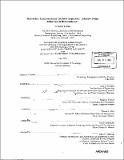| dc.contributor.advisor | Earl M. Murman. | en_US |
| dc.contributor.author | Dare, Robert E. (Robert Ernest), 1961- | en_US |
| dc.contributor.other | Massachusetts Institute of Technology. Technology, Management, and Policy Program. | en_US |
| dc.date.accessioned | 2006-03-24T16:06:35Z | |
| dc.date.available | 2006-03-24T16:06:35Z | |
| dc.date.copyright | 2003 | en_US |
| dc.date.issued | 2003 | en_US |
| dc.identifier.uri | http://hdl.handle.net/1721.1/29602 | |
| dc.description | Thesis (Ph. D.)--Massachusetts Institute of Technology, Engineering Systems Division, Technology, Management, and Policy Program, 2003. | en_US |
| dc.description | Includes bibliographical references (p. 308-311). | en_US |
| dc.description.abstract | Air Force development of new or evolutionary weapon systems is a complex endeavor due to the involvement of many stakeholders and the presence of considerable uncertainty in the acquisition environment. The ability to adapt a weapon system while it is still being designed affords a means to respond to this complexity. The fundamental motivation for this research is to discover how Air Force development programs, operating within established constraints, can improve their adaptability during the design phase to provide more value to the warfighter. The thesis of this research is that the quality and nature of collaboration between stakeholders during the design phase of weapon system development programs determines how effectively they share knowledge, which in turn drives the level of program adaptability. Eight case studies were conducted on Air Force development programs. Data were collected on collaborative practices and patterns of adaptability demonstrated during design. The research placed an emphasis on usage of "system representations" such as prototypes and beta software releases that acted as a form of boundary object to facilitate knowledge sharing across organizational boundaries. As programs used system representations to provide higher levels of knowledge sharing, they were found to be more adaptable. System representations were more effective at promoting adaptability when they represented the design with higher fidelity, providing system-level detail and covering stakeholder emphasis areas. Lastly, certain key stakeholder roles were found to contribute both flexibility and structure, facilitating a "zone of novelty" in which the stakeholders could exercise creativity and evaluate design options while still executing the program within established constraints. | en_US |
| dc.description.abstract | (cont.) This research indicates that the pressing need for Air Force programs to be able to adapt in today's uncertain acquisition environment can be addressed to a significant degree through the usage of effective system representations in conjunction with supporting patterns of stakeholder interaction. Specific recommendations for Air Force acquisition policy makers and practitioners are provided. | en_US |
| dc.description.statementofresponsibility | by Robert E. Dare. | en_US |
| dc.format.extent | 333 p. | en_US |
| dc.format.extent | 13711539 bytes | |
| dc.format.extent | 24091320 bytes | |
| dc.format.mimetype | application/pdf | |
| dc.format.mimetype | application/pdf | |
| dc.language.iso | eng | en_US |
| dc.publisher | Massachusetts Institute of Technology | en_US |
| dc.rights | M.I.T. theses are protected by copyright. They may be viewed from this source for any purpose, but reproduction or distribution in any format is prohibited without written permission. See provided URL for inquiries about permission. | en_US |
| dc.rights.uri | http://dspace.mit.edu/handle/1721.1/7582 | |
| dc.subject | Technology, Management, and Policy Program. | en_US |
| dc.title | Stakeholder collaboration in Air Force acquisition : adaptive design using system representations | en_US |
| dc.type | Thesis | en_US |
| dc.description.degree | Ph.D. | en_US |
| dc.contributor.department | Massachusetts Institute of Technology. Engineering Systems Division | |
| dc.contributor.department | Technology and Policy Program | |
| dc.identifier.oclc | 53072734 | en_US |
